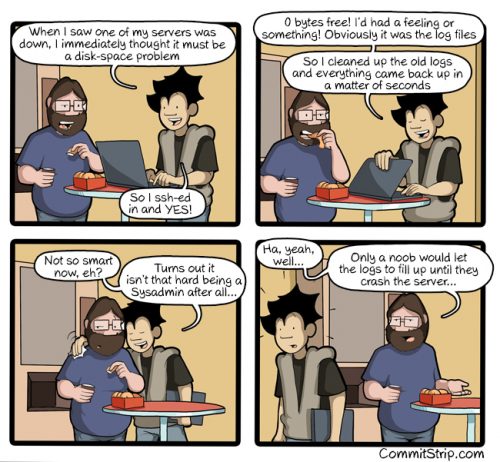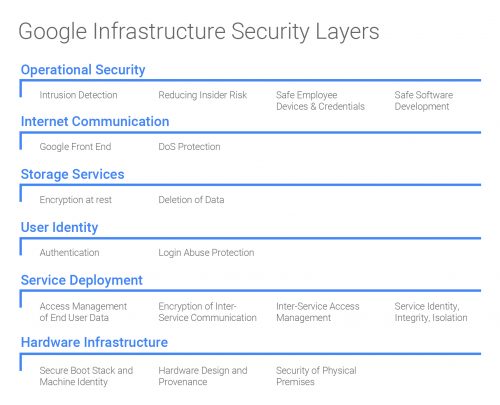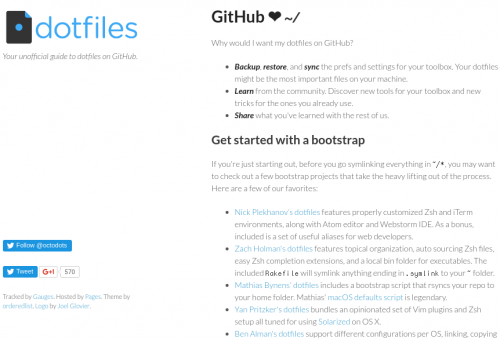One more for the CommitStrip.
Category: Sysadmin
System administration is a special are of IT. It also has a special place in my heart. It is an interesting mixture of all the other disciplines, both common across the whole industry, and at the same time unique for each person, company, and geographical location. When I have something to say or share about system administration, I use this category.
Google Infrastructure Security Design Overview
If you ever wanted to know what Google does to maintain its high level of security, here’s your chance. Google Infrastructure Security Design Overview provides quite a bit of information on the subject.
This document gives an overview of how security is designed into Google’s technical infrastructure. This global scale infrastructure is designed to provide security through the entire information processing lifecycle at Google. This infrastructure provides secure deployment of services, secure storage of data with end user privacy safeguards, secure communications between services, secure and private communication with customers over the internet, and safe operation by administrators.
How Linux got to be Linux: Test driving 1993-2003 distros
Here’s a trip down the memory lane – “How Linux got to be Linux: Test driving 1993-2003 distros“. The article looks at some of the early Linux distributions, remember what was already in and what came later. Complete with screenshots.
I don’t remember for sure which versions of which distributions I used in the early days, but Slackware, Suse, RedHat and Mandrake were definitely among those. Slackware was probably my first one, when I found the floppies in the only book on Linux at my college library. Then, somehow, I found RedHat (I think 5.1 or so) in one of the local computer shops. Later I tried Mandrake and Suse, cause those were laying around at work. But RedHat stuck with me ever since. I think I’ve used pretty much every version, including the move to Fedora, CentOS, and even the Red Hat Enterprise Linux, which we had the licenses for at some of my early work places.
Fun times!
dotfiles – your unofficial guide to dotfiles on GitHub
Warning: you will lose a lot of sleep if you follow the link below. :)
No matter how well you know Vim, bash, git, and a whole slew of other command line tools, I promise you, you’ll find something new, something you had no idea existed, something that will help you save hours and hours of your life by shaving off a few seconds here and there on the tasks you perform on a daily basis, in the repositories link to from this site.
I think I’ve spent most of my Sunday there and my dotfiles are so different now that I’m not sure I should commit and push them all in one go. I think I might need to get used to the changes first.
Some of the things that I’ve found for myself:
- PHP Integration environment for Vim (spf13/PIV).
- myrepos – provides a
mrcommand, which is a tool to manage all your version control repositories. - bash-it – a community Bash framework.
- Awesome dotfiles – a curated list of dotfiles resources.
… and a whole lot of snippets, tips, and tricks.
P.S.: Make sure you don’t spend too much time on these things though :)
Amazon Linux AMI : Let’s Encrypt : ImportError: No module named interface
Let’s Encrypt has only experimental support for the Amazon Linux AMI, so it’s kind of expected to have issues once in a while. Here’s one I came across today:
# /opt/letsencrypt/certbot-auto renew Creating virtual environment... Installing Python packages... Installation succeeded. Traceback (most recent call last): File "/root/.local/share/letsencrypt/bin/letsencrypt", line 7, in <module> from certbot.main import main File "/root/.local/share/letsencrypt/local/lib/python2.7/dist-packages/certbot/main.py", line 12, in <module> import zope.component File "/root/.local/share/letsencrypt/local/lib/python2.7/dist-packages/zope/component/__init__.py", line 16, in <module> from zope.interface import Interface ImportError: No module named interface
My first though was to install the system updates. It looks like something is off in the Python-land. But even after the “yum update” was done, the issue was still there. A quick Google search later, thanks to the this GitHub issue and this comment, the solution is the following:
pip install pip --upgrade pip install virtualenv --upgrade virtualenv -p /usr/bin/python27 venv27
Running the renewal of the certificates works as expected after this.
P.S.: I wish we had fewer package and dependency managers in the world…



